In the previous article we made an introduction and overview of the topic of thematic investing, including its definition, scope, and the three main areas: disruptive technology or innovation, megatrends, and sustainability.
In the next articles we will develop the first two areas, since sustainability has already been widely addressed in several articles of the series dedicated to Investing in ESG.
This article, which unfolds in two parts, focuses on technology and disruptive innovation, starting by presenting the speed of innovation adoption over time, the definition of disruptive technology and innovation, and the various waves of this innovation and economic growth.
The change and speed of adoption of disruption
What is disruptive technology or innovation?
Waves of disruptive innovation and economic growth
The change and speed of adoption of disruption
Before we address technology and disruptive innovation, it is worth keeping in mind the evolution of the speed of diffusion/adhesion of it.
The following chart shows how long various product categories, from electricity to the Internet, took to reach different levels of penetration in U.S. homes:
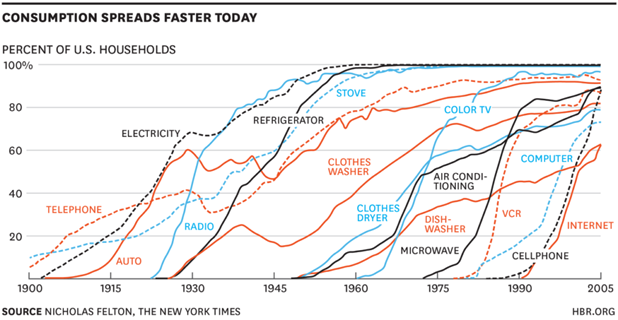
It took decades for the telephone to reach 50 percent of households, starting before 1900.
It took five years or less for mobile phones to achieve the same penetration in 1990.
As can be seen, the most recently introduced innovations are adopted more and more rapidly.
Consequently, companies with competitive advantages in these areas will need to move faster to capture the opportunities that present themselves.
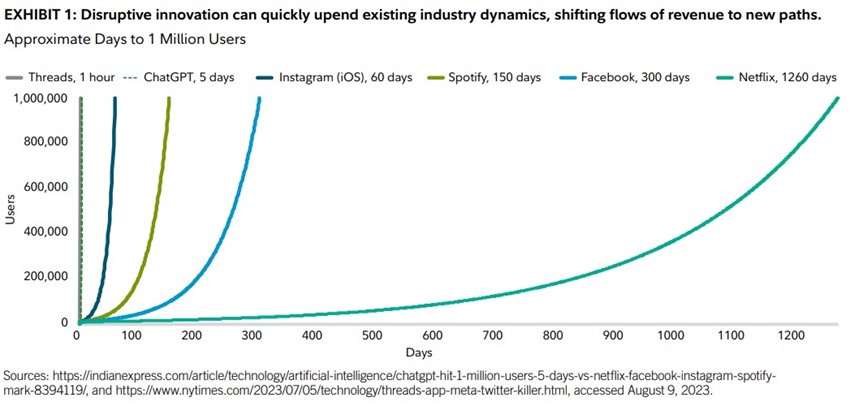
Chat GPT has been praised for reaching 100 million users in a few months.
In July 2023, this record was broken by the Threads app, which exceeded this limit by five days.
The rapid rise of Threads, a new social media texting service created by Meta (which rivals X, formerly Twitter), highlights another important aspect of disruptive investing: the pioneer isn’t always the one who achieves breakthroughs in the industry.
What is disruptive technology or innovation?
In business theory, disruptive innovation is innovation that creates a new market and a new value network, or enters the foundation of an existing market, and eventually replaces and eliminates established market-leading companies, products, and alliances.
Disruptive technology is an innovation that significantly alters the way consumers, industries, or businesses operate.
A disruptive technology eliminates the systems or habits it replaces because it has attributes that are recognized as superior.
This circumstance makes it possible for disruptive businesses to reach neglected customer segments and gain a foothold in the sector.
Often, established companies do not have the flexibility to adapt quickly to new threats. This allows disruptors to move upstream over time and cannibalize more customer segments.
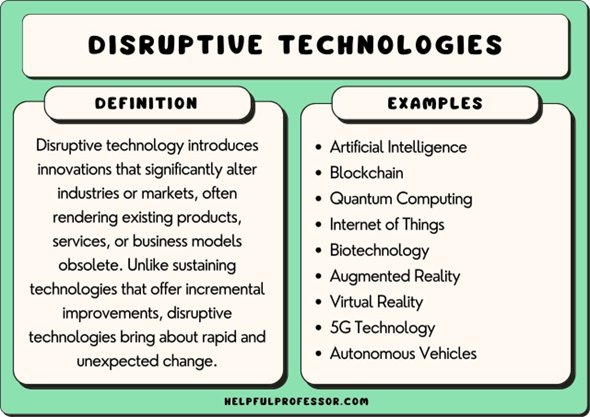
Recent examples of disruptive technology include e-commerce, online news sites, ride-hailing apps, and GPS systems.
In his day, the automobile, electricity service, and television were disruptive technologies.
Disruptive technologies are difficult to anticipate because they can appear suddenly.
Although the term “disruptive innovation” was popularized by the American academic Clayton Christensen, the concept had already been described previously in the book “Innovation: The Attacker’s Advantage” by Richard N. Foster, and in his article “Strategic responses to technological threats”, in 1976, as well as by Joseph Schumpeter in the book “Capitalism, Socialism and Democracy (as creative destruction)”, in 1942.
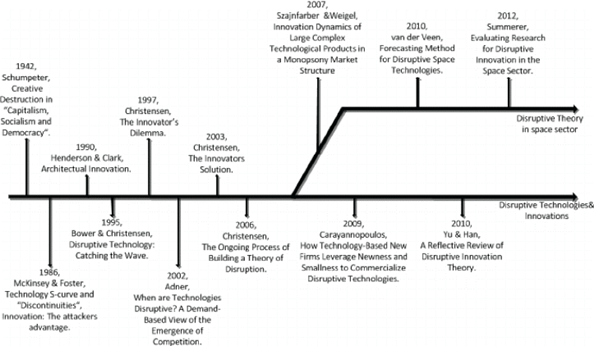
Waves of disruptive innovation and economic growth
Technological innovation and economic growth are closely related and can be articulated within the concept of cycles, or waves.
Each wave represents a phase of diffusion of a series of technological innovations that create entirely new economic sectors and opportunities for investment and growth.
Since the beginning of the industrial revolution in the late 18th century, six waves have been identified:
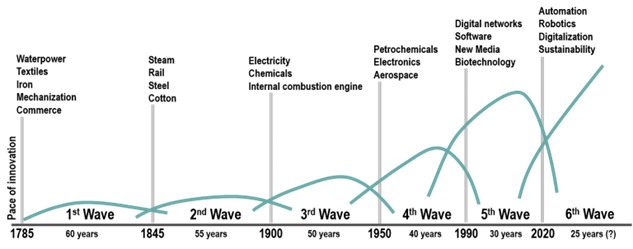
1st wave (1785-1845)
It relied on innovations such as hydraulic power, textiles and iron. The beginning of the Industrial Revolution focused primarily on simple goods such as clothing and tools that could benefit many people.
Conventional maritime technology based on sailing ships was perfected, supporting the trade and navigation of the great empires.
Production and transportation costs have been significantly reduced.
2nd wave (1845-1900)
It involved the massive application of coal as an energy source, mainly through the steam engine. This has led to the development of rail transport systems, opening up new markets and providing access to a wider range of resources domestically and internationally.
The steamship had a similar impact on shipping and allowed for expanded trade opportunities in global trade. In addition, the mass production of cotton has substantially improved the opportunities of the textile industry, making clothing items much more affordable.
3rd wave (1900-1950)
Electrification was a major economic change, as it allowed the use of a variety of machines and appliances. It also allowed the development of urban transport systems, such as metros and buses.
Another significant improvement was the internal combustion engine, around which the entire automotive industry was created and expanded passenger and freight mobility.
4th wave (1950-1990)
The post-World War II period represented significant industrial changes with new materials such as plastics (petrochemicals) and new sectors such as electronics (television).
The jet engine expanded the aviation industry toward the mass market, and mobility could be realized globally.
5th wave (1990-2020)
The development of information systems has substantially improved the transactional environment with new methods of communication and more efficient ways of managing production and distribution systems (logistics).
This has spawned new industries related to personal computing devices, primarily computer manufacturing and software programming, but more recently, e-commerce platforms.
6th wave (2020-?)
The key technologies that are likely to be the drivers of the 6th wave are already in place and mainly include robotics, automation, digitalization, and sustainability.
Digitalisation implies a high level of information technologies in goods and services, as well as in their management and operations.
The 6th wave has also been labeled as the fourth industrial revolution.
These waves are related to the stages of development of the world economy.
As time went by, the lapse between each wave became shorter. For example, the first wave lasted 60 years, while the fourth lasted 40 years. This reflects a growing potential for innovation and the ability of economic systems to derive commercial opportunities from an innovation once adopted.
Innovations are much less the result of individual efforts, but are organized and concerted actions whose results are quickly disseminated.
Moreover, at the end of a cycle, the rate of innovation usually decreases, as most of the major innovations in the driving sector have already taken place, and the industry has been captured by commercial and regulatory interests that focus more on the pursuit of yield than on innovation.



















